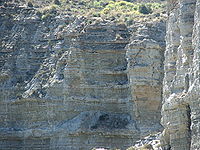Cyclostratigraphy

Cyclostratigraphy is like a really cool way of studying how the Earth and other planets move around the Sun. It’s kind of like watching the Earth on a spinning top and counting how many times it goes around in a day. But instead of days, we are counting cycles, or patterns of movement, that happen over long periods of time, like millions of years.
Scientists can do this by studying rocks and fossils that are millions of years old. They look at tiny details in the rocks, like layers or bands, and they can see patterns in these layers that repeat over and over again. These patterns are caused by cycles in the Earth’s movement, like changes in the tilt of its axis or how close it is to the Sun.
By studying these cyclical patterns, scientists can learn a lot about the past, like what the climate was like or how the continents moved around. It’s kind of like being a detective and figuring out clues to solve a mystery!
So, basically, cyclostratigraphy is a way of looking at patterns in ancient rocks to understand more about how the Earth and other planets have moved around in the past. It’s cool because it helps us learn more about our planet’s history and how it has changed over millions of years.
Scientists can do this by studying rocks and fossils that are millions of years old. They look at tiny details in the rocks, like layers or bands, and they can see patterns in these layers that repeat over and over again. These patterns are caused by cycles in the Earth’s movement, like changes in the tilt of its axis or how close it is to the Sun.
By studying these cyclical patterns, scientists can learn a lot about the past, like what the climate was like or how the continents moved around. It’s kind of like being a detective and figuring out clues to solve a mystery!
So, basically, cyclostratigraphy is a way of looking at patterns in ancient rocks to understand more about how the Earth and other planets have moved around in the past. It’s cool because it helps us learn more about our planet’s history and how it has changed over millions of years.
Related topics others have asked about:
